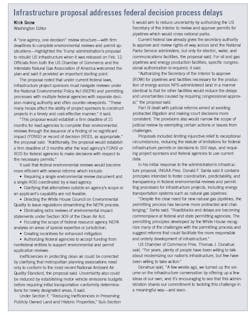Improved infrastructure key to US energy dominance, Senate panel told
The US energy transportation system already is one of the world's best, witnesses told the US Senate Energy and Natural Resources Committee. But it won't help reach the Trump administration's goal of achieving global energy dominance without more cooperation between state and federal agencies in issuing permits for projects, they warned during a Feb. 8 hearing.
More certainty regarding permits is essential, representatives of both the natural gas and electricity industries agreed. "Often, this issue is framed as states vs. the federal government, when it actually is state vs. state," Interstate Natural Gas Association Pres. Donald F. Santa said.
He suggested that the New York State Department of Environmental Protection's use of authority under the Clean Water Act's Section 401 to stop construction of an interstate gas pipeline-which the US Federal Energy Regulatory Commission has approved-actually denies producers in Pennsylvania a market for their gas in New England.
"I believe some recourse is needed, such as what exists under the Coastal Zone Management Act for appeals of a state's permit denial directly to the US Secretary of Commerce instead of having the problem wind up in court," Santa said.
"This affects electric utilities increasingly as more of then turn to gas to generate power," added Phillip D. Moeller, executive vice-president for business operations and regulatory affairs at the Edison Electric Institute. "Our members would support congressional action to address this problem." Electric utilities encounter similar problems when they try to construct interstate power transmission lines, Moeller said.
"There's been a lot of private sector investment already to build infrastructure from both gas and electricity production sites to US consumers, but more will be needed," noted Kenneth B. Medlock III, who is an energy and resource economics fellow at Rice University's James A. Baker Institute for Public Policy in Houston.
When there's not enough energy transportation capacity, short-term supply and demand movements can lead to significant price dislocations, Medlock said. "Notably, if demand swings due to seasonal factors, this can result in excessive price volatility as the constraint is realized and relaxed over and over again," he said. "However, if we had delivery capability to the market, the constraint is relaxed, even at the higher level of demand, and the price falls despite actual consumption rising."
He pointed out that several factors contributed to the dramatically improved domestic oil and gas outlook since 2008, including:
• A regulatory and legal apparatus in which producers can negotiate directly with property owners for access to mineral rights on privately owned land.
• A market in which hubs, which act as liquid pricing locations, are easily reached due to liberalized transportation services with pipeline capacity unbundled from pipeline ownership.
• A well-developed pipeline network that can facilitate production volumes as they are brought online.
• A market in which interstate pipeline development is relatively seamless due to a well-established governing body (FERC) and a comparatively straightforward regulatory approval process.
• A market in which demand pull is sufficient and can materialize with minimal regulatory impediments, to provide the opportunity for new supplies to compete for market share.
• A market where a well-developed service sector already exists which can facilitate fast-paced drilling activity and provide rapid responses to demands in the field.
• A service sector which must compete by reducing costs and improving techniques to gain a competitive advantage.
• A sizeable rig fleet capable of responding to upstream demands without constraint.
• A deep set of upstream actors including independent producers who can behave as entrepreneurs, facilitating a flow of capital toward smaller scale, riskier ventures than those vertically integrated major oil and gas companies pursue.
"Every one of these bullet points has some relevance to infrastructure-from permitting to access to market function to price formation to investment, etc.," Medlock said. "If any one of these factors is absent, it presents an effective market development barrier, usually in the form of higher costs. Moreover, some of the above sufficient conditions can co-depend on others, which highlights the notion that well-designed market institutions and regulatory frameworks can be self-reinforcing."
The coexistence of these factors makes the US a unique environment for upstream shale-directed investments, he said. "This, in turn, highlights the importance of each in achieving US energy-related geopolitical and foreign policy aims. More specifically, the legacy of domestic regulatory and market institutions engenders significant global influence, and infrastructure has played a central role in fostering the current reality."
Santa said that enhancements to the interstate gas pipeline network will continue to be needed, the process of obtaining the necessary permits will have to become better coordinated, and the concept of cooperative federalism will need to be restored.
About the Author

Nick Snow
NICK SNOW covered oil and gas in Washington for more than 30 years. He worked in several capacities for The Oil Daily and was founding editor of Petroleum Finance Week before joining OGJ as its Washington correspondent in September 2005 and becoming its full-time Washington editor in October 2007. He retired from OGJ in January 2020.

